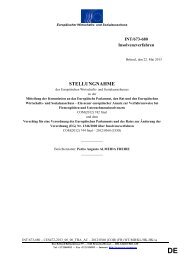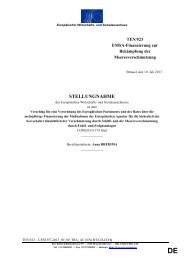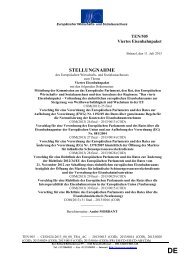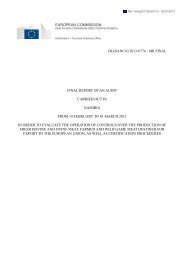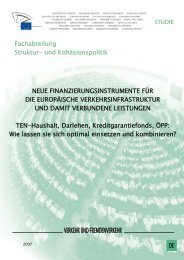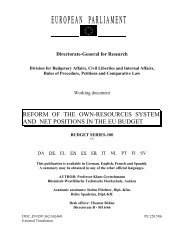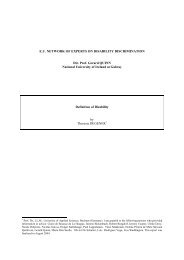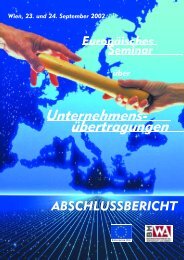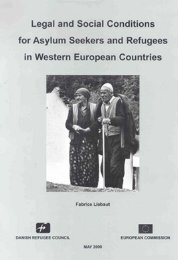Bulgaria - The social impact of seasonal migration
Bulgaria - The social impact of seasonal migration
Bulgaria - The social impact of seasonal migration
You also want an ePaper? Increase the reach of your titles
YUMPU automatically turns print PDFs into web optimized ePapers that Google loves.
IV<br />
factors is extremely high. <strong>The</strong> globalisation <strong>of</strong> economy and politics, the continuos<br />
merging <strong>of</strong> cultural factors and the shortening <strong>of</strong> distances by the availability <strong>of</strong> quick<br />
and cheap transportation, makes regular <strong>migration</strong> always hard to isolate as a regional<br />
phenomenon or to control by national means. We have come to understand that<br />
Migration has its own internal dynamics. <strong>The</strong>se particular dynamics – sensitive <strong>of</strong><br />
course to external factors –can be maybe best compared with what liberals would<br />
describe as a marketplace. A place, where reality is the clash product <strong>of</strong> a demand and<br />
an <strong>of</strong>fer, and where intervention can only be done with observance to these<br />
mechanisms. Arbitrary intervention can and does usually lead to unwanted results.<br />
Before we attempt to develop this concept, let us enumerate briefly three more<br />
assumptions that are relevant for these internal dynamics, when discussing the<br />
marketplace approach: 1. First <strong>of</strong> all, the quantitative (as opposed to qualitative) degree<br />
<strong>of</strong> migratory movements always depends on the extent to which restrictive actions have<br />
hindered the <strong>migration</strong> process previously. Recent history <strong>of</strong> the continent has<br />
illustrated significantly enough this statement and comparing 1980 and 1990 statistics<br />
gives you a clear picture. 2. Very much related to the above assumption, one could<br />
safely talk about fluctuating cycles in <strong>migration</strong>, with ascending lines, peaks and<br />
regressions. In Europe, most <strong>of</strong> the Candidate Countries have passed their peaks in<br />
producing <strong>migration</strong> in the mid-90s. 3. Migration, especially the one motivated<br />
economically, is more sensitive to pull than to push factors. This assumption is very<br />
much relevant in Europe today, and it radically contradicts whoever states that the<br />
European Union has little to <strong>of</strong>fer to migrants. <strong>The</strong> fact is that there are jobs available in<br />
the Union today, particularly in certain areas <strong>of</strong> the labour market. Migrants will satisfy<br />
this demand within or outside a regulated framework. Further it might very well be that<br />
legislators and policy maker who want to intervene in a certain manner on this<br />
marketplace would only be able to succeed by working precisely at these pull-factors.<br />
<strong>The</strong> way some countries do it – maybe the most relevant are the US and Canada –<br />
proving that they have understood this reality by attracting qualified migrants from all<br />
over the world, becoming preferred destinations even for people who are not that<br />
dependent on push factors in their own countries. And the moment is not far when<br />
competition between European and non-European destinations for qualified migrants<br />
may have a much more decisive <strong>impact</strong> on trends then the aforementioned<br />
demographic changes. Having taken into account these assumptions and coming back<br />
to the <strong>migration</strong> marketplace, maybe the first corollary <strong>of</strong> this analogy is the fact that as<br />
long as <strong>migration</strong> happens – with no regard to the policy <strong>of</strong> the state – it is pro<strong>of</strong> enough<br />
that migrants are actually needed. As long as the movements are driven by labour<br />
related issues, the interior dynamics <strong>of</strong> <strong>migration</strong>, as said earlier, will always take<br />
precedence, no matter if the destination state will restrict it or not. <strong>The</strong> difference is only<br />
in the degree <strong>of</strong> legality within which the economic activities <strong>of</strong> the migrants (usually<br />
labour) will happen. In Europe this is both true in the member states <strong>of</strong> the EU and will<br />
be progressively more and more true in the Candidate Countries as they approach<br />
accession.<br />
As we shift towards the particular European dimension <strong>of</strong> the marketplace analogy, one<br />
would say that state intervention has to be always in agreement with the intrinsic state<br />
<strong>of</strong> the determinant factors at the moment <strong>of</strong> intervention, and should ideally be justified<br />
by an unusual imbalance <strong>of</strong> the migratory “market”. That means that when a state<br />
designs its policy on <strong>migration</strong> or other way to control migratory movements such



